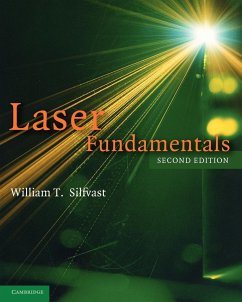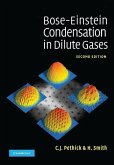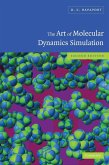William T. Silfvast
Laser Fundamentals
William T. Silfvast
Laser Fundamentals
- Broschiertes Buch
- Merkliste
- Auf die Merkliste
- Bewerten Bewerten
- Teilen
- Produkt teilen
- Produkterinnerung
- Produkterinnerung
Laser Fundamentals provides an introduction to the physical and engineering principles of laser operation and design.
Andere Kunden interessierten sich auch für
![Elementary Particle Physics Elementary Particle Physics]() Andrew J. LarkoskiElementary Particle Physics78,99 €
Andrew J. LarkoskiElementary Particle Physics78,99 €![Vortex Dynamics Vortex Dynamics]() P. G. StaffmanVortex Dynamics75,99 €
P. G. StaffmanVortex Dynamics75,99 €![Bose-Einstein Condensation in Dilute Gases Bose-Einstein Condensation in Dilute Gases]() C. J. PethickBose-Einstein Condensation in Dilute Gases112,99 €
C. J. PethickBose-Einstein Condensation in Dilute Gases112,99 €![The Art of Molecular Dynamics Simulation The Art of Molecular Dynamics Simulation]() D. C. RapaportThe Art of Molecular Dynamics Simulation141,99 €
D. C. RapaportThe Art of Molecular Dynamics Simulation141,99 €![Principles of Plasma Diagnostics Principles of Plasma Diagnostics]() I. H. HutchinsonPrinciples of Plasma Diagnostics112,99 €
I. H. HutchinsonPrinciples of Plasma Diagnostics112,99 €![Relativistic Quantum Physics Relativistic Quantum Physics]() Tommy OhlssonRelativistic Quantum Physics85,99 €
Tommy OhlssonRelativistic Quantum Physics85,99 €![Collisional Transport in Magnetized Plasmas Collisional Transport in Magnetized Plasmas]() Per HelanderCollisional Transport in Magnetized Plasmas83,99 €
Per HelanderCollisional Transport in Magnetized Plasmas83,99 €-
-
-
Laser Fundamentals provides an introduction to the physical and engineering principles of laser operation and design.
Produktdetails
- Produktdetails
- Verlag: Cambridge University Press
- 2. Auflage
- Seitenzahl: 674
- Erscheinungstermin: 30. Mai 2012
- Englisch
- Abmessung: 254mm x 203mm x 36mm
- Gewicht: 1421g
- ISBN-13: 9780521541053
- ISBN-10: 0521541050
- Artikelnr.: 25044059
- Herstellerkennzeichnung
- Libri GmbH
- Europaallee 1
- 36244 Bad Hersfeld
- gpsr@libri.de
- Verlag: Cambridge University Press
- 2. Auflage
- Seitenzahl: 674
- Erscheinungstermin: 30. Mai 2012
- Englisch
- Abmessung: 254mm x 203mm x 36mm
- Gewicht: 1421g
- ISBN-13: 9780521541053
- ISBN-10: 0521541050
- Artikelnr.: 25044059
- Herstellerkennzeichnung
- Libri GmbH
- Europaallee 1
- 36244 Bad Hersfeld
- gpsr@libri.de
William Silfvast received a BSc degree in both physics and mathematics and a PhD in physics from the University of Utah. In 1990, he joined the faculty of the University of Central Florida in Orlando, Florida where he was Professor of Physics and Electrical Engineering as well as a member of the Center for Research and Education in Optics and Lasers (CREOL). In 1999 he also became a Professor of Optics at the School of Optics. He is presently Emeritus Professor of Optics. He is a Fellow of the American Physical Society, the Optical Society of America and the IEEE. He has carried out pioneering work in the fields of metal vapor lasers, recombination lasers, photoionization-pumped lasers, laser plasmas, and EUV lithography. He is the author of over 100 technical papers and holds more than 30 patents.
1. Introduction
Part I. Fundamental Wave Properties of Light: 2. Wave nature of light - the interacting of light with materials
Part II. Fundamental Quantum Properties of Light: 3. The particle nature of light - discrete energy levels
4. Radiative transitions and emission linewidth
5. Energy levels and radiative properties of molecules, liquids (organic dyes) and solids (dielectrics and semiconductors)
6. Radiation and thermal equilibrium - absorption and stimulated emission
Part III. Laser Amplifiers: 7. Conditions for producing a laser - population inversions, gain, and gain saturation
8. Laser oscillation above threshold
9. Requirements for obtaining population inversions
10. Laser pumping requirements and techniques
Part IV. Laser Resonators: 11. Laser resonator modes
12. Stable laser resonators and Gaussian beams
13. Special laser cavities
Part V. Specific Laser Systems: 14. Laser systems involving low density gain media
15. Laser systems involving high density gain media
Part VI. Frequency Multiplication of Laser Beams: 16. Frequency multiplication of lasers and other non linear optical effects.
Part I. Fundamental Wave Properties of Light: 2. Wave nature of light - the interacting of light with materials
Part II. Fundamental Quantum Properties of Light: 3. The particle nature of light - discrete energy levels
4. Radiative transitions and emission linewidth
5. Energy levels and radiative properties of molecules, liquids (organic dyes) and solids (dielectrics and semiconductors)
6. Radiation and thermal equilibrium - absorption and stimulated emission
Part III. Laser Amplifiers: 7. Conditions for producing a laser - population inversions, gain, and gain saturation
8. Laser oscillation above threshold
9. Requirements for obtaining population inversions
10. Laser pumping requirements and techniques
Part IV. Laser Resonators: 11. Laser resonator modes
12. Stable laser resonators and Gaussian beams
13. Special laser cavities
Part V. Specific Laser Systems: 14. Laser systems involving low density gain media
15. Laser systems involving high density gain media
Part VI. Frequency Multiplication of Laser Beams: 16. Frequency multiplication of lasers and other non linear optical effects.
1. Introduction
Part I. Fundamental Wave Properties of Light: 2. Wave nature of light - the interacting of light with materials
Part II. Fundamental Quantum Properties of Light: 3. The particle nature of light - discrete energy levels
4. Radiative transitions and emission linewidth
5. Energy levels and radiative properties of molecules, liquids (organic dyes) and solids (dielectrics and semiconductors)
6. Radiation and thermal equilibrium - absorption and stimulated emission
Part III. Laser Amplifiers: 7. Conditions for producing a laser - population inversions, gain, and gain saturation
8. Laser oscillation above threshold
9. Requirements for obtaining population inversions
10. Laser pumping requirements and techniques
Part IV. Laser Resonators: 11. Laser resonator modes
12. Stable laser resonators and Gaussian beams
13. Special laser cavities
Part V. Specific Laser Systems: 14. Laser systems involving low density gain media
15. Laser systems involving high density gain media
Part VI. Frequency Multiplication of Laser Beams: 16. Frequency multiplication of lasers and other non linear optical effects.
Part I. Fundamental Wave Properties of Light: 2. Wave nature of light - the interacting of light with materials
Part II. Fundamental Quantum Properties of Light: 3. The particle nature of light - discrete energy levels
4. Radiative transitions and emission linewidth
5. Energy levels and radiative properties of molecules, liquids (organic dyes) and solids (dielectrics and semiconductors)
6. Radiation and thermal equilibrium - absorption and stimulated emission
Part III. Laser Amplifiers: 7. Conditions for producing a laser - population inversions, gain, and gain saturation
8. Laser oscillation above threshold
9. Requirements for obtaining population inversions
10. Laser pumping requirements and techniques
Part IV. Laser Resonators: 11. Laser resonator modes
12. Stable laser resonators and Gaussian beams
13. Special laser cavities
Part V. Specific Laser Systems: 14. Laser systems involving low density gain media
15. Laser systems involving high density gain media
Part VI. Frequency Multiplication of Laser Beams: 16. Frequency multiplication of lasers and other non linear optical effects.









